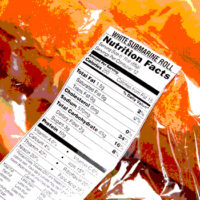Sponsored Content
Overcoming Issues with Perfluorinated Compound Analyses

Perfluorinated compounds (PFCs or perfluoroalkoxy compounds) compose a family of molecules that consist of varying lengths of fluorocarbons chains with a functional group, such as a carboxylic or sulfonic acid, attached. They have been used for more than 50 years in various products, such as firefighting foams, hydrophobic and nonstick coatings, and surfactants.[1] They are particularly resistant to degradation and tend to accumulate in organisms and the environment. PFCs have been the subject of increased scrutiny in recent years because of their potential adverse effects on human health. These compounds likely move into crops and livestock from contaminated soils and water sources. They are also commonly found in food packaging.[2]
Analyses of PFCs in a laboratory can be complicated. They are ubiquitous and abundant in lab settings because of their presence in some laboratory equipment, making them a very common source of analytical contamination. They also tend to adsorb onto surfaces. To achieve an accurate analysis, some precautions must be applied during protocol preparation and execution.
The Importance of Defining the Appropriate Protocol, Equipment, and Supply
Several reports describe the proper practices for PFC decontamination, sample collection, and analysis.[3–5] These articles typically recommend using a high-density polypropylene or standard polypropylene for sampling and nitrile gloves, which should be replaced frequently to prevent contamination. Because PFCs adsorb onto glass surfaces, the use of glass containers should be avoided. In addition, any items with nonstick or hydrophobic coatings, also referred to as polytetrafluoroethylene (PTFE) coatings, may contain PFCs and must not be used. If PTFE equipment needs to be used, it should be tested to ensure that it does not lead to unacceptable PFC concentrations. Sampling bottles should be discarded after use to avoid cross-contamination, and it’s important to note that some plastic materials may contain trace levels of PFCs (e.g., collection tubes, pipette tips). Finally, all items used in the analysis, including solvents, should be tested for the presence of PFCs that could lead to false positives.
Some PFCs adsorb onto surfaces, including polypropylene, especially when in the aqueous phase. If that is the case, it is strongly advised to avoid the transfer of a sample from one container to another. The aqueous sample container must also be rinsed with organic solvent (e.g., methanol) that will be included in the analysis. It is strongly recommended to use internal standards to determine possible matrix effects. In addition, the treated samples should contain a high percentage of solvent (at least 50% methanol) to avoid adsorption.
Reducing Background Contamination from Devices
High-performance liquid chromatography (HPLC) components often contain PTFE parts and tubing. This, coupled with possible trace levels of PFCs in solvents, can hinder the analysis of samples with low PFC concentrations. The PFCs released from HPLC components build up at the top of the chromatographic column, creating higher background interference. There are two solutions available to reduce such interference. The first solution is to replace the PTFE parts and perfluorinated tubing, and use PFC-free solvents. This solution is limited because it is expensive to set up and can be challenging to obtain solvents free of PFCs.
Another solution is to install a delay column between the LC pump and the injector. PFCs from solvents and LC pumps will build up at the top of the delay column, resulting in a shift of the retention time of the interfering PFCs during analysis. This solution is easy to implement and is a more cost-effective solution.
If automation is used (e.g., for solid-phase extraction, SPE), you must ensure there are no PTFE parts and that the solvent and sample lines are replaced with polyetheretherketone tubing.
SPE to the Rescue
Newer analytical devices are typically very efficient in detecting PFCs and may allow direct injection for trace analysis. However, even with great care, contamination might occur during sample processing, with chances of contamination issues increasing with lower PFC concentrations in a sample. Other problems also exist. Many samples are too dirty to directly inject and require the use of purification techniques. In addition, the analysis of ultralow levels of PFCs (below parts per trillion) requires concentrating the sample before analysis.
.png) ??SPE can concentrate and purify PFCs from various samples, making their detection easier. Moreover, the SPE process is easily automated,[6] which removes the potential for human contamination in the sample processing. Unfortunately, classic SPE cartridges are usually contaminated by small amounts of PFCs. This contamination can arise during manufacturing or can be present in some of the materials used. The levels of contamination can vary from lot to lot, with several commercially available SPE cartridges containing high levels of PFCs.[7]
??SPE can concentrate and purify PFCs from various samples, making their detection easier. Moreover, the SPE process is easily automated,[6] which removes the potential for human contamination in the sample processing. Unfortunately, classic SPE cartridges are usually contaminated by small amounts of PFCs. This contamination can arise during manufacturing or can be present in some of the materials used. The levels of contamination can vary from lot to lot, with several commercially available SPE cartridges containing high levels of PFCs.[7]
To overcome PFC contamination issues with SPE, AFFINISEP, a global provider of ready-to-use laboratory consumables, including SPE cartridges, SPE disks, spin cartridges and tips, custom resins, and products for passive sampling, recently introduced a new product—AttractSPE™ WAX-PFC. AtractSPE™ WAX-PFC SPE cartridges are specifically designed for PFC analysis. The cartridges are manufactured with materials that are selected and controlled to have the least possible amounts of PFC contaminants in order to perform trace or ultra-trace PFC analysis. The cartridges use a weak anion exchange (WAX) resin to efficiently capture PFCs based on ionic interactions in various applications. For example, the cartridges can concentrate and purify PFCs from large volumes of drinking water. Since its introduction, the AttractSPE™ WAX-PFC cartridges have consistently demonstrated high capacity retention and excellent performance, with recoveries above 90 percent.
The AttractSPE™ WAX-PFC solution provides:
- The consumables, including the AttractSPE™ WAX-PFC cartridges (reference: WAX-PFC-50.S6.150), the delay column (reference: C18LCP-50.2.1), and the chromatographic column (reference: C18LCP-150.2.1).
- A global solution to facilitate the analysis of PFCs, including technical tips and technical support.
- An LC-mass spectrometry (MS)/MS analytical method and corresponding application notes covering PFC detection in various matrices.
AFFINISEP provides innovative kits (analytical chemistry, radiochemistry, and diagnostics) to analytical and R&D laboratories, small laboratories, and leading academic institutes around the world. AFFINISEP's kits focus on topical concerns about the quality and safety of food and agricultural products, as well as the monitoring of water quality and other products. Learn more at AFFINISEP.com.
1. www.mfe.govt.nz/sites/default/files/media/Hazards/Tonkin&Taylor Non foam PFAS sources - FINAL.pdf.
3. www.epa.gov/water-research/epa-drinking-water-research-methods.
5. pfas-1.itrcweb.org/wp-content/uploads/2018/01/pfas_fact_sheet_regulations__1_4_18.pdf.
6. www.affinisep.fr/media/affinisep_attractspe_wax_pfc_for_perfluorinated_cpds_automate_gilson.pdf.
7. Buresova, M, et al. 2019. “Analysis of Perfluoroalkylated Substances (PFAS) in Water, Part A: SPE Columns as a Source of Background Contamination in PFAS Trace Analysis.” Poster presented at RAFA 2019, Prague.
Looking for a reprint of this article?
From high-res PDFs to custom plaques, order your copy today!





